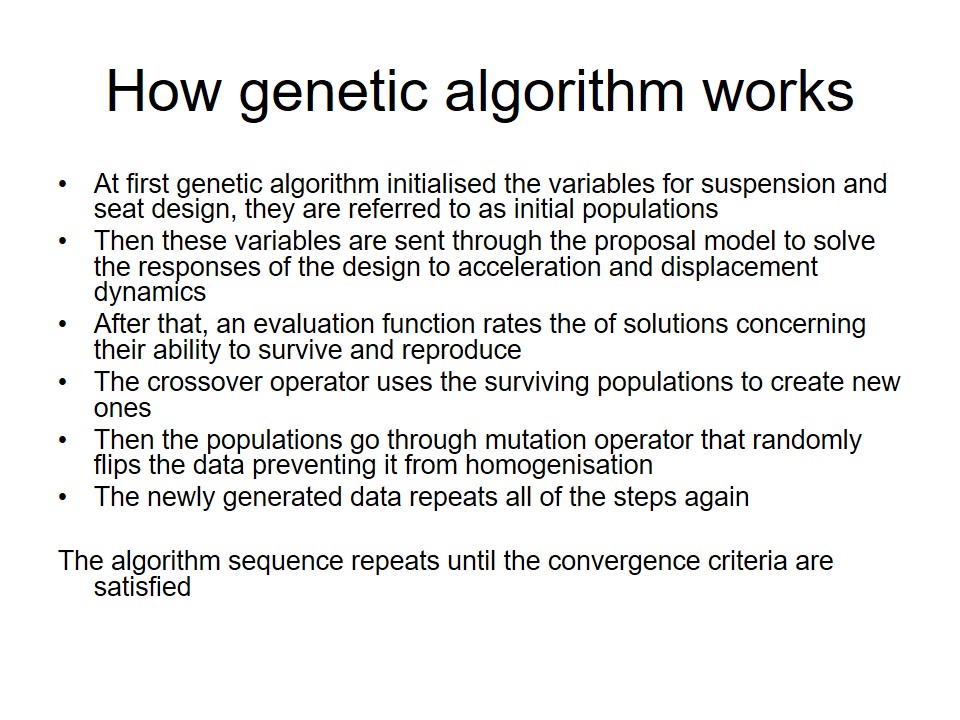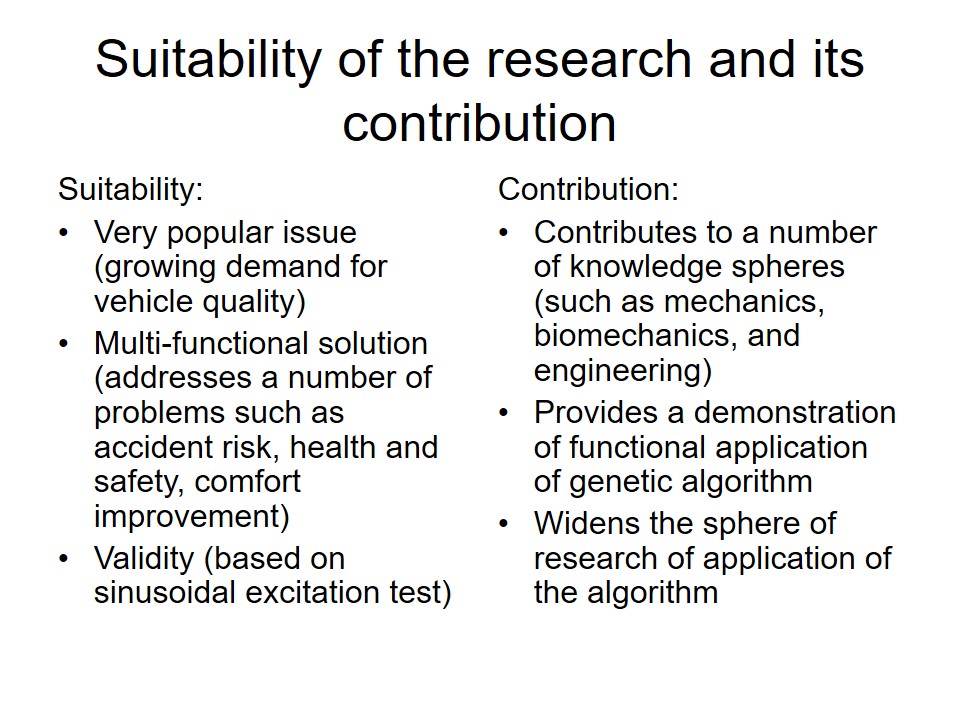Vehicle use in the contemporary world
- Rapidly growing use of vehicles due to higher importance of transportation and communications due to complex logistics and supply chains.
- Increasing popularity of travelling as a hobby and a business necessity.
- Globalisation leading to the need for quicker results on the long distances.
The factors mentioned above lead to the growth of popularity of motor vehicles for people of all classes and statuses. Besides, the average time the contemporary individuals spend driving is also increasing. As a result, the modern operators pay more careful attention to the quality of the vehicles and the level of control they are able to provide for the drivers.

Vehicle quality
- Vehicle seat quality influences:
- Comfort of the driver;
- Physical fatigue (may lead to exhaustion and loss of focus);
- Safety (increases the chance of accidents and aggravates their outcomes);
- Health (may cause injuries of spine, neck, lumbar, pelvis).
- Affected individuals:
- Professional drivers (delivery workers, cabmen, transportation employees, long distance lorry drivers);
- Travelers who spend multiple hours driving;
- People with higher needs for comfort (pregnant women, elderly people, individuals with various health conditions).
The effects caused by driving a vehicle with low quality seat which maintains heavy levels of vibration affect the operators that spend a lot of time driving. The longer one spends at the wheel, the worse the effects are. Negative impact of vibration while driving are often overlooked, yet, they create serious health problems for the vehicle operators causing acceleration and displacement of various body parts, aggravating fatigue from driving and leading to fast exhaustion.

Appearance and effects of vibration
- The imperfections of the road interact with the car.
- The vibration of the car spreads to the driver’s seat.
- In case if the seat is not designed to damp the vibration, it affects the whole body of the vehicle operator.
- Constant vibration negatively impacts vertebra of the neck, leads to muscle tension, the need for constant body adjustment, spine deterioration.
Specially designed car seat suspension:
- Will have more appropriate mass to resist vibration.
- Will respond to the vibration.
- Reduce the major portion of it.
- Will damp head acceleration.
- Allow more comfortable driving.
Many contemporary drivers are used to the feeling of vibration, so it often is unnoticed, but the serious negative impacts it is able to produce on the human body are scientifically proved. This way, the contemporary drivers are in need for a new design of a seat suspension which would provide safety and comfort for the operators.

Genetic Algorithm
- Is a global optimisation technique that is used in engineering to search for designs minimising an objective function subject to constraints.
- Is currently researched by mathematicians, mechanics, engineers, biomechanics and many other scientists as a means to work with complex functions with multiple objectives.
- Can be successfully applied to solve a number of complex tasks.
Genetic algorithm is a contemporary method of working with multi-objective functions. It allows the scientists to develop optimised designs of constructions fulfilling several different functions and responding to a list of conditions. Since the construction of a car seat suspension responsive to vibrations during operation is rather complicated, genetic algorithm was employed to optimise its design.

How genetic algorithm works
- At first genetic algorithm initialised the variables for suspension and seat design, they are referred to as initial populations.
- Then these variables are sent through the proposal model to solve the responses of the design to acceleration and displacement dynamics.
- After that, an evaluation function rates the of solutions concerning their ability to survive and reproduce.
- The crossover operator uses the surviving populations to create new ones.
- Then the populations go through mutation operator that randomly flips the data preventing it from homogenisation.
- The newly generated data repeats all of the steps again.
- The algorithm sequence repeats until the convergence criteria are satisfied.
The algorithm is called genetic because it is based on the way genetics works in the nature. Data (genome) is sorted according to its fitness (ability to survive and reproduce), randomly flipped (to avoid mutations happening due to homogeneity of the bits of genotype, population is mixed up in order to deliver new information.

The results of the application of genetic algorithm
Sinusoidal excitation comparison applied to acceleration and displacement of:
- Head.
- Lower torso.
- Upper torso.
- Pelvis.
Result: 84-86 % peak overshoot reduction in the design generated by the genetic algorithm.
The solution found due to the use of the genetic algorithm was compared to the data provided by the current suspensions. With the help of sinusoidal excitation the car seat suspension was evaluated. The evaluation showed significant difference between the currently used suspension design and the one produced by the genetic algorithm. The suspension design developed with the help of genetic algorithm turned out to be much more effective for the response towards vibration. The researchers provide diagrams illustrating the difference between passive suspension and the new one. The difference is striking, which demonstrated the efficiency of the application of genetic algorithm to the complex problems with multiple conditions.

Suitability of the research and its contribution
- Suitability:
- Very popular issue (growing demand for vehicle quality).
- Multi-functional solution (addresses a number of problems such as accident risk, health and safety, comfort improvement).
- Validity (based on sinusoidal excitation test).
- Contribution:
- Contributes to a number of knowledge spheres (such as mechanics, biomechanics, and engineering).
- Provides a demonstration of functional application of genetic algorithm.
- Widens the sphere of research of application of the algorithm.
The review of the presented research paper reveals its efficiency and usefulness for the contemporary society and its needs. Besides, providing a clear demonstration of the application of genetic algorithm to search for solution for a complex design the scientists show the range of opportunities the algorithm provides for the researchers. This optimisation technique proves to be very functional and helpful in engineering and mechanics.

Future research suggestions
- Suspension customisation (for various types of roads and different kinds of drivers).
- Application for various vehicle models.
- Use in sport (for example, Formula One race cars with more severe vibration level).
- Possibility of application for airborne vehicles (planes, helicopters).
Vibration in general is a rather harmful influence for the human body, the negative effects of vibration grow along with the time spent in a vibrating vehicle. This way, the findings of the presented research demonstrate that vehicles of various kinds can be adjusted and made safer for the operators. Of course, the calculation process that is already very complex will be complicated by a number of new parameters, yet the algorithm reveals great perspectives in the spheres of mechanics and engineering and potentially may allow solving the issues of unwanted vibrations in all kinds of moving vehicle models. The article called “Optimal Seat and Suspension Design for a Half-Car with Driver Model Using Genetic Algorithm” by Wael Abbas, Ashraf Emam, Saeed Badran, Mohamed Shebl, and Ossama Abouelatta shows that genetic algorithm-based optimization carries great future for the sciense and engineering of nowadays.
